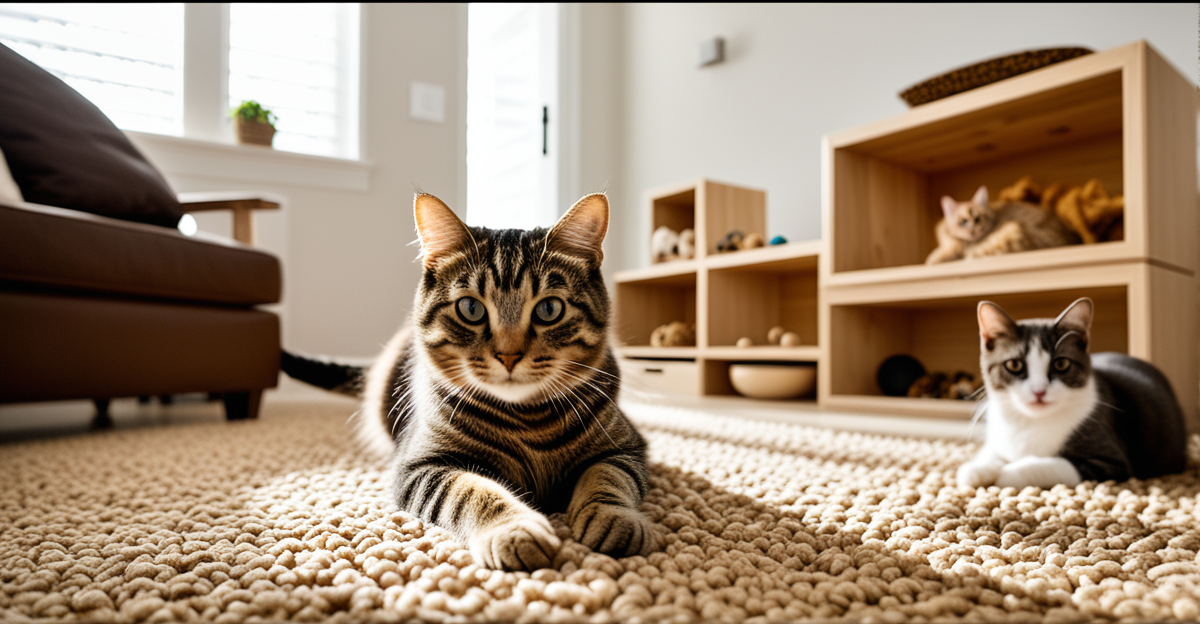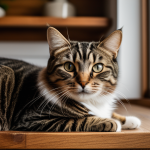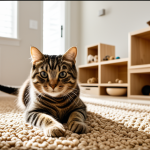Understanding the Needs of Blind Cats
Blind cats are unique creatures with specific needs, particularly in terms of environment and sensory engagement. Understanding these needs is crucial for their overall well-being. Here, we delve into some common behaviors and how sensory play plays a vital role in their lives.
Firstly, the environment is of utmost importance for blind cats. They rely heavily on memory and their other senses to navigate their surroundings. Therefore, having a consistent and familiar space helps reduce stress and increases their sense of security.
A voir aussi : Ultimate Guide to Managing Polycystic Kidney Disease in Cats: Innovative Diet Plans and Medication Strategies
Blind cats often exhibit behaviors tailored to augment their sensory input. They may frequently rub against surfaces to understand their environment or follow familiar scent trails. These behaviors underscore their dependence on remaining senses and highlight the importance of maintaining a consistent setting.
Sensory play is indispensable for blind cats. Engaging in activities that stimulate their other senses can significantly improve their quality of life. For instance, tactile stimulation using varied textures offers them a rich sensory experience, while interactive toys with gentle sounds can provide auditory excitement, keeping them mentally and physically active. Understanding and catering to these needs not only enhances their well-being but also fosters a deeper connection between blind cats and their caregivers.
Sujet a lire : Designing a Comfortable Sanctuary: The Ultimate Guide to Senior Cat-Friendly Homes
Designing a Safe and Stimulating Play Area
Creating a safe play area design is essential for blind cats, ensuring they experience both fun and security. Selecting a suitable location is the first step, as it plays a critical role in setting the environment’s tone. Look for quiet spaces away from high traffic areas, which will provide a sense of calm and help them feel more secure.
Selecting a Suitable Location
Opt for a location without hazardous obstacles. Keep the space consistent to help blind cats orient themselves confidently.
Creating Boundaries
Clear boundaries are key in a safe play area design. Use furniture or safe materials to segment the space. These boundaries guide their movement and mitigate potential accidents.
Ensuring a Secure Environment
Selective use of ramps and interactive obstacles introduces beneficial challenges while encouraging activity. Avoid harmful materials like loose strings that can pose choking risks. Invest in vertical spaces; secure wall attachments or platforms grant blind cats a safe space to explore heights. Regular cat safety reviews assess and maintain the secure nature of the play area.
Essential Materials and Toys for Blind Cats
Blind cats benefit significantly from toys designed to engage their remaining senses. When selecting cat toys, consider their ability to stimulate tactile, auditory, and scent responses. Sensory toys offer blind cats opportunities to explore and interact with their environment in a meaningful way.
- Interactive toys with built-in sounds, like gentle crinkles or chimes, cater to a blind cat’s keen hearing, providing them with hours of entertainment.
- For tactile stimulation, opt for toys with varied textures, such as soft plush or nubby surfaces. These textures can pique a cat’s interest and encourage playful interaction.
Choosing safe materials is critical. Ensure that toys are constructed from non-toxic substances and are robust enough to withstand rigorous play, thereby reducing ingestion hazards. Avoid small parts that can detach easily and become choking risks.
For those interested in DIY options, creating simple toys from household materials is an excellent choice. Stuff old socks with dried beans for a rattling effect, or tie a few soft ribbons for an enticing tangle. These DIY options not only provide sensory enrichment but also foster a sense of creativity and resourcefulness in caregiving for blind cats.
Incorporating Sensory Stimulation Strategies
Sensory stimulation is vital for enhancing the quality of life for blind cats. By utilizing sensory enrichment activities, caregivers can significantly impact their well-being and encourage playful behaviour.
Auditory Stimulation
Blind cats rely heavily on sound. Using toys with gentle chimes or crinkles can provide them with enjoyable auditory experiences. Additionally, engaging them with music or using voice recordings can help create a peaceful atmosphere.
Tactile Stimulation
Stimulating the tactile senses is critical for blind cats. Different textures, such as soft plush or ribbed surfaces, offer varied physical sensations. Blankets with contrasting materials can be placed strategically around their environment to pique their curiosity.
Scent-Based Activities
Scent plays a key role in the navigation of blind cats. Incorporating scent-based activities can guide them safely and keep them engaged. Scent trails can be created using herbs like catnip, helping cats familiarize themselves with and traverse their surroundings confidently.
Through ample sensory stimulation, caregivers can ensure blind cats remain active, content, and deeply bonded with their environment. This not only enhances their quality of life but also fosters an enriching experience for both the cats and their caregivers.
Safety Considerations in Play Area Setup
Ensuring cat safety is paramount when designing a play area for blind cats. Conducting a thorough risk assessment helps in identifying potential hazards that could cause injury or stress.
Identifying Potential Hazards
Regularly inspect the space for sharp edges, toxic plants, or unsecured items that might pose risks. Prevent accidents by securing furniture and eliminating any small objects that could be swallowed. The use of non-toxic materials is vital, especially for chew toys and climbing structures.
Regular Safety Checks and Maintenance
Establish a routine for regular safety checks to maintain a secure environment. Monitor the condition of toys and accessories, replacing anything showing signs of wear that could be hazardous. It’s essential to adapt the space based on changing needs or behaviours of blind cats, ensuring safety remains uncompromised.
Importance of Non-Toxic Materials
To protect your cat, always opt for non-toxic, sturdy materials in the play area. Ensure all items, from toys to furnishings, adhere to safety standards. Be particularly cautious with paints or finishes, confirming they are safe for animal use.
Prioritizing safety fosters a secure, stimulating environment that supports the well-being of blind cats, ensuring they can explore confidently.
Testimonials and Case Studies
Engaging with cat owner experiences reveals invaluable insights into the care of blind cats. A success story emerges from Sarah, who transformed her chaotic apartment into a sanctuary for her visually impaired feline. With a strategic arrangement of sensory toys and consistent layout, her cat now navigates with confidence, reducing stress. Sensory play—integrating sound and tactile elements—proved pivotal in enhancing their bond.
Another tale from Mark emphasises the impact of thoughtful play area setups. After implementing tactile trails and auditory cues, his blind cat became more active, even finding joy in exploring vertical spaces. He notes, “The key is patience and understanding their sensory needs.”
These success stories underscore the transformative power of tailored environments. Insights from cat owners highlight the importance of routine in establishing familiarity, encouraging blind cats to thrive. Many learned that gradual introductions to new stimuli prevent overwhelming their feline companions while fostering a safe explorative atmosphere.
Such shared experiences provide guidance and inspiration, showcasing the profound effect of personalised care on blind cat well-being. Lessons learned stress the necessity of empathy and innovation in meeting their unique needs.
Additional Resources and Visual Aids
When navigating the complexities of blind cat care, leveraging comprehensive resources and visual aids can provide invaluable support. These resources for cat care offer insights into creating an enriching environment tailored to their needs.
Links to Helpful Articles
Diving into expert-authored articles can illuminate best practices for setting up an optimal play area. These publications often include checklists for play area setup, ensuring a thorough approach to creating a safe haven.
Checklists for Play Area Setup
Structured checklists serve as practical guides, detailing essential steps for ensuring cat safety and promoting well-being. They simplify processes like identifying hazards and selecting appropriate materials, empowering caregivers to make informed decisions.
Visual Guides for Layout Planning
Visual aids, such as infographics, present ideas for ideal layouts, showcasing how to integrate sensory stimulation into the blind cat’s environment effectively. These guides assist in visualizing space usage and arrangement, incorporating things like ramps for safe exploration.
Complementing these resources, online communities and forums unite like-minded caregivers, facilitating cat owner experiences exchange. This collective knowledge fosters a supportive network, enriching both individual understanding and community welfare. Moreover, downloadable resources provide templates and inspiration for those crafting customised spaces for their blind companions.










